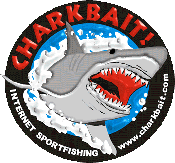|
FLUOROCARBON LEADER COMPARISON
08/28/09 - REVISED
by
Mark Smith
Caveats on Comparisons and Claims - Blowing-up Some
Hype and Hot Air
New Testing Performed 08/27/09
When we first began carrying fluorocarbon leader there were
few suppliers, and all shared some similar characteristics. We only supported
100% fluorocarbon leader, never a coated product. All proved to be nearly invisible in
water. When folks would ask for a recommendation I'd simply say, "just make sure
it's 100% FL, beyond that they're all pretty much equal." All manufacturer's
products were stiff, and all absorbed a bit of water. Most importantly, all
proved very effective when it came time to go fishing. When the bite was picky,
fluorocarbon leader could make a difference - a big difference. I've seen days
when you couldn't buy a bite unless you were using the stuff, and I've also seen
days when it made absolutely no difference since the fish were eating everything
that touched the water...including cigarette butts!
As time
passed, more manufacturers entered the field. As a result we've seen some
competition between manufacturers each trying to gain some marketing advantage.
Sometimes marketing claims are made that exceed proven results, sometimes the
hype is only hot air blown by an over-reaching sales/marketing department. As a
fishing tackle retailer I share some common concerns with our clients. We can't
stock everything, and the stuff we stock had better work or I've blown dollars
that should be used elsewhere. So, we do some testing here as a regular course
of business. We have invested in test equipment and try to look beyond the hype
to sort out facts.
So, let's get
down to business. I have been of the opinion that all fluorocarbon leaders are
pretty much equal, so long as they are 100% fluorocarbon. That's been my
opinion, but based upon this testing it looks like I'll need to revise my
thinking a bit. We are hearing some
claims from certain manufacturers about strength, softness, diameter and
stretch... various properties beyond pure fishing effectiveness. It was our
intent to do some simple testing to see if there really are any differences
between products. We chose to evaluate Seaguar Blue Label and their new Premier,
P-Line, Hi Seas Quattro, and Blackwater in this testing. We
omitted some manufacturers, may revisit this exercise at a later date to add
their statistics to the mix. In the case of Seaguar, we chose their best
two lines and omitted their older and less expensive Red Label - which was a
first generation line. The Blue Label is the second generation, and probably the
most popular saltwater fluorocarbon line on the market, with many big fish in
the bag already. It was an update of the Red Label in terms of adding
specialized saltwater characteristics such as increased test performance
and abrasion resistance. The Premier is a third generation product, with claims
of increased softness, increased stretch and lower diameter. Hi Seas Quattro is
a relatively new entrant to the scene, the product we tested was introduced
at the 2009 ICAST show. It's the least expensive of the lines tested, and
is uniquely tinted. Blackwater's line came on the market in 2007, with much
promotion on the West Coast, boosting it's use as a "shock leader" offering
greater stretch and better for applications requiring direct ties to Spectra.
This line was heavily promoted by some of the San Diego based landings, and may
have had some tie-in in that regard. P-Line's fluorocarbon was one of the
earliest products on the market, following Seaguar's first offerings of this
type of leader material. It has some very loyal followers and is quite popular
nationally. The P-Line product has been a very good value in terms of pricing
and quality over the years, offering lines in all tests with some strong loyalty
among the long range crowd. P-Line has been promoted as a line that is the most
conservatively rated in terms of test performance. We'll check the hype
through testing of the line's diameter, breaking strength, stretch and feel.
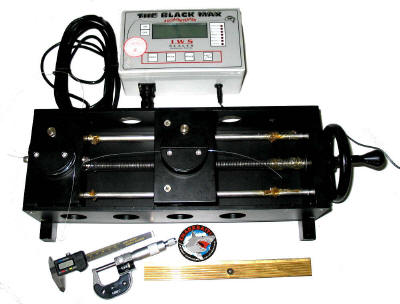 TEST
EQUIPMENT TEST
EQUIPMENT
We used a
$2.6K line tester made by Scale Master. The Black Max is IGFA certified, used in
many tournaments, and VERY RELIABLE. We also used a couple different micrometers
to arrive at line diameter measurements.
PROBLEMS
WITH STUDY
Our sample was
not huge, only 10 tries per line test/per manufacturer. We only used one spool
of line (pulled from our shelf) for testing purposes. The lines were not wet,
they were dry and this could result in different findings in the field. While we
tried to treat all measures consistently, this does not mean that we mimicked
the way a fish would run and pull on the line. We were consistent with the
pressure, not jerky, so real world conditions were not met.
METHOD
First, I used
a 3' section of leader and checked the line diameter in a minimum of three different
locations on the line and arrived at an average measurement. Usually there were
very small variances, insignificant. Then, I cut a 4' section and put it
in the Black Max tester. The "jaws" were closed allowing only a 1" gap of line.
Then the jaws were moved apart at a steady rate until the line snapped. At that
point we'd check the breaking test and also measure how much stretch was
achieved prior to breaking. This was repeated 10 times for each line, I dropped
the top and bottom scores and only recorded four measures from each supplier for
this evaluation allowing for a greater cluster at or near the median.
Those numbers provided the mean measurement which is what we'll examine for
comparison. Then we also compared standard deviations of the break strength and
stretch rate. The lower the deviation the better - indicating higher consistency
of product. We also measured the correlation between line diameter and breaking
strength, and as assumed this would reflect a high correlation - which it certainly
did. There is no way for us to measure the line's stiffness, but stretch can
prove indicative of this quality: stiffer lines typically have less stretch.
But, we did employ a subjective Leiter scale to this task. We asked employees
and shop customers to rank the five different lines in terms of limpness, with 1
being most limp and 5 being the stiffest - by feel.
Comparisons
were made with 20#, 40# and 60# lines, all tested on the same date and under the
same conditions.
OBSERVATIONS & OPINIONS
Line diameter is an important consideration when comparing performance. We've
seen many claims by mono manufacturers about how strong their line is, without
reference to diameter. [For what it's worth, Izor based their line on diameter,
using Ande as a reference. Ande's 20# line measured a certain size, Izor's line
of the same diameter was marketed as a 20# line, when in reality it would test
far higher based upon newer copolymer manufacturing.] In our testing, we did
find that fluorocarbon leader does indeed stretch less than mono, however we
were surprised to see that in general it does stretch more than we initially
thought possible.
As one would expect, we found a positive correlation between line diameter and break strength,
and a positive relationship between break strength and stretch.
In our testing, we did find that fluorocarbon leader does indeed stretch less
than mono, however we were surprised to see that in general it does stretch more
than we initially thought possible. Products from ALL manufacturers allowed some
degree of stretch. Products from ALL manufacturers strength tested well, most at or
beyond their claimed rating in the 20-40# rating. However, once we started
looking at 60# lines things changed. At that test many lines did not perform up
to stated spec using our methods. Please look over the findings for the 60#
category if you are a long range fisherman. Those results may make one go back
to their old favorite line in a heart beat. Seaguar's Blue Label, long a
favorite, tested the best at the higher rating. In terms of stretch, Seaguar's
Premier (a third generation product from the folks that first brought FL lines
to fishermen) offered the best stretch and consistency (lowest standard
deviations between tests) and lowest diameters. (More about the "stretch and
shock leader" fact and fantasy in the next paragraph.) Hi Seas Quattro brand
also performed very well in the lower tests of 40# and down. However, I noticed
that at the higher test their line broke in strange ways and less than desired
test. It appeared that the line would separate and almost splinter. Not sure
why, but will ask the manufacturer about this. Their 40-20# line appeared very
good, and with the unique tinting, represents something I'll be fishing in
strong sunlight conditions. For long range fishing, I'm most positive about
Seaguar's Premier and their Blue Label lines. For big fish, 200# or better, I'm
inclined to go with them.
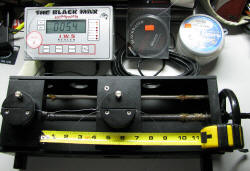 |
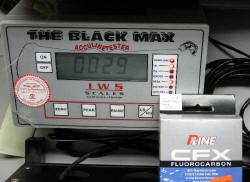 |
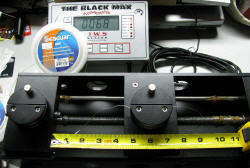 |
| Blackwater 60# Testing |
P-Line 20# Tests |
Seaguar Blue Label 60# Test |
What's the point of the stretch and shock leader consideration? Well, if you were trying to run a short topshot of
fluorocarbon leader into your spectra backing, having some stretch would be a
good thing. Perhaps you might chose your fluorocarbon based upon stated stretch
measurements. From the limited research we did, under the conditions we used,
I'd be hard pressed to recommend one FL line over another from the standpoint of
stretch alone, but there was a clear winner in this regard. I'd also look at other properties
beyond stretch, many of which are beyond the scope
of this writing. For instance, limpness, ability to maintain strength after
being in water for 30 minutes... These are important real world considerations, I
feel. From the standpoint of breaking strength and stretch, I will make no claims
regarding one manufacturer or another based only upon the results from this
comparison. That's something you might do for yourself... You should also couple
this consideration with the line diameter spec. It's fairly easy to offer a
thicker line, under rate it's test rating, and then claim to have the strongest
line in a particular line test class. It's simple, and it's a bit bogus in my
opinion. So, look at the diameter as well as the breaking strength. One thing I can
certainly state quite clearly, there's a great deal of hype surrounding one
particular manufacturer's claim to have better "shock leader" qualities based
upon stretch. Without naming names, I will simply state that their claims are a
fantasy and represent nothing more than hype. It's easy to go over the numbers
below to see which line has the thinnest diameter, which line has the highest
breaking strength and which line does in fact offer the best elongation or
stretch aiding in shock/snap line breakage. It's easy for a manufacturer to
claim higher breaking strengths simply by increasing the line's diameter size.
We found one example of that in our evaluation, a technique often used on the
mono side of things. With respect to "stretch" or shock leader claims, well, I
think we burst one bubble of hype that's been on the boards for a couple years
now. That particular line carried a high price, too high a price to pay for it's
hype alone. Testing did NOT back up their claims in the area of stretch - and
that's something we also proved in the testing we did in 2007. One name I will
state clearly that impressed me was Seaguar's Premier and their Blue Label
lines. The Premier has a very thin diameter, lower variation in performance
(smaller standard deviation scores in testing) higher stretch... Their Blue Label
offshore line also tested very well in terms of conservative test ratings. It
combines strength, conservative line test ratings (what you expect to get, you
do) and reasonable diameter.
Data Set
Used for Evaluation - Diameter, Break Strength & Deviation
| |
mnfg |
|
|
|
|
|
mean |
|
correlation |
ratio |
| |
claimed diameter |
tested diameter |
break strength 1 |
break strength 2 |
break strength 3 |
break strength 4 |
break strength |
standard deviation |
diameter:break |
break/diameter |
| Hi Seas Quatro |
|
|
|
|
|
|
|
1:1 expected |
|
| 20# |
0.4 |
0.39 |
28 |
28 |
27.7 |
29.7 |
28.35 |
0.911043358 |
0.998691 |
72.692308 |
| 40# |
0.6 |
0.57 |
41 |
37 |
43 |
44 |
41.25 |
3.095695937 |
|
72.368421 |
| 60# |
0.75 |
0.71 |
56 |
49 |
52 |
56 |
53.25 |
3.403429643 |
|
75.000000 |
| |
|
|
|
|
|
|
|
|
|
|
| Seaguar Blue |
|
|
|
|
|
|
|
|
|
| 20# |
0.405 |
0.39 |
31 |
30 |
30 |
31 |
30.50 |
0.577350269 |
0.996531 |
78.205128 |
| 40# |
0.6 |
0.61 |
51 |
51 |
50 |
50 |
50.50 |
0.577350269 |
|
82.786885 |
| 60# |
0.74 |
0.74 |
65 |
68 |
66 |
67 |
66.50 |
1.290994449 |
|
89.864865 |
| |
|
|
|
|
|
|
|
|
|
|
|
Seaguar Premier - Top Performing based
upon diameter and breaking strength consideration |
| 20# |
0.37 |
0.34 |
27 |
29 |
30 |
29 |
28.75 |
1.258305739 |
0.996255 |
84.558824 |
| 40# |
0.57 |
0.55 |
41 |
46 |
47 |
45 |
44.75 |
2.62995564 |
|
81.363636 |
| 60# |
0.7 |
0.69 |
60 |
57 |
59 |
61 |
59.25 |
1.707825128 |
|
85.869565 |
| |
|
|
|
|
|
|
|
|
|
|
| Blackwater |
|
|
|
|
|
|
|
|
|
| 20# |
not stated |
0.4 |
30 |
31 |
29 |
29 |
29.75 |
0.957427108 |
0.997472 |
74.375000 |
| 40# |
not stated |
0.62 |
50 |
45 |
42 |
45 |
45.50 |
3.31662479 |
|
73.387097 |
| 60# |
not stated |
0.75 |
50 |
54 |
54 |
52 |
52.50 |
1.914854216 |
|
70.000000 |
| |
|
|
|
|
|
|
|
|
|
|
| P-Line |
|
|
|
|
|
|
|
|
|
|
| 20# |
0.42 |
0.4 |
32 |
29 |
28 |
29 |
29.50 |
1.732050808 |
0.999932 |
73.750000 |
| 40# |
0.6 |
0.62 |
44 |
46 |
45 |
45 |
45.00 |
0.816496581 |
|
72.580645 |
| 60# |
0.73 |
0.78 |
59 |
52 |
58 |
58 |
56.75 |
3.201562119 |
|
72.756410 |
| |
|
|
|
|
|
|
|
|
|
|
| Yo-Zuri |
|
|
|
|
|
|
|
|
|
|
| 20# |
0.34 |
0.43 |
19 |
21 |
22 |
27 |
22.25 |
3.403429643 |
0.997915 |
|
| 40# |
0.59 |
0.62 |
36 |
40 |
40 |
44 |
40.00 |
3.265986324 |
|
|
| 60# |
0.68 |
0.77 |
57 |
40 |
44 |
53 |
48.50 |
7.85281266 |
|
|
| |
|
|
|
|
|
|
|
|
|
|
|
Things to consider: line diameter is one important consideration,
especially important when testing breaking strength so that we're
comparing apples to apples. The lower the number, for a given line
test, the better. Mean or average breaking strength is also a
quality to focus on in this evaluation, as is the standard deviation
(which points to variance in this quality). A lower standard
deviation score is desirable. The ratio between breaking strength
and diameter is also an important consideration. It's easy to
play games with higher break strength, based on fatter lines.
|
| |
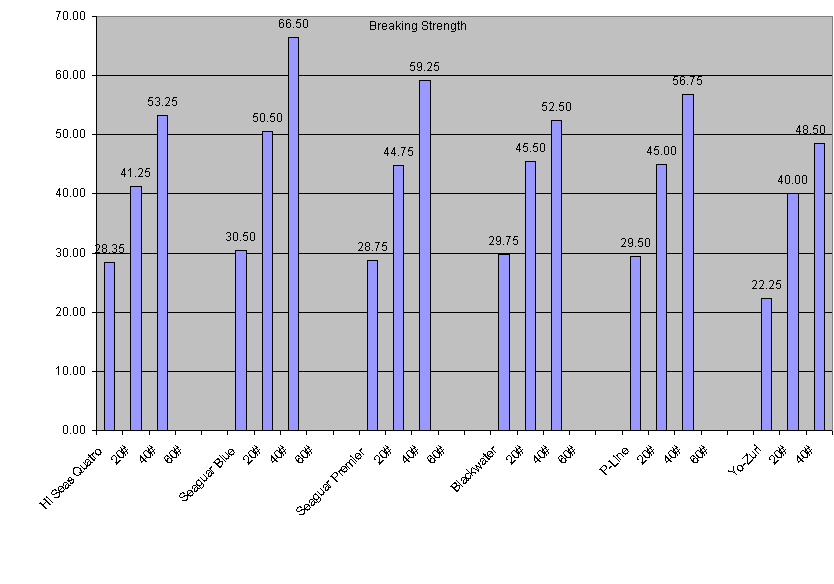 |
Data Set
Used for Evaluation - Stretch, Deviation and Feel -
limpness/stiffness
| |
stretch 1 |
stretch 2 |
stretch 3 |
stretch 4 |
mean stretch |
standard deviation |
feel-limpness |
rank |
| Hi Seas Quatro |
|
|
|
|
(lower the better) |
Subjective Leighter Scale 1=limpest |
| 20# |
7.5 |
4.75 |
3.4 |
4.5 |
5.22 |
1.743261 |
3.25 |
#3 |
| 40# |
3.4 |
2.7 |
4 |
3.6 |
3.37 |
0.543906 |
3 |
#3 |
| 60# |
4 |
4.2 |
4.4 |
4.2 |
4.20 |
0.163299 |
2.5 |
#2 |
| |
|
|
|
|
|
|
|
|
| Seaguar Blue |
|
|
|
|
|
|
|
| 20# |
3.4 |
3.4 |
3.4 |
3.3 |
3.40 |
0.050000 |
3 |
#2 |
| 40# |
4.2 |
4.25 |
4.3 |
4.3 |
4.25 |
0.047871 |
1.75 |
#2 |
| 60# |
4.6 |
4.25 |
4.3 |
4.4 |
4.38 |
0.154785 |
3.5 |
#4 |
| |
|
|
|
|
|
|
|
|
|
Seaguar Premier - Top Performing Brand
based upon stretch - used as shock leader |
| 20# |
4.25 |
4.25 |
4.25 |
4.3 |
4.25 |
0.025000 |
1 |
#1 |
| 40# |
4 |
4.75 |
4.75 |
4.6 |
4.50 |
0.357071 |
1.25 |
#1 |
| 60# |
5.25 |
4.75 |
4.75 |
4.8 |
4.92 |
0.242813 |
2 |
#1 |
| |
|
|
|
|
|
|
|
|
| Blackwater |
|
|
|
|
|
|
|
| 20# |
3.5 |
3 |
3.3 |
3.2 |
3.27 |
0.208167 |
4.5 |
#4 |
| 40# |
4 |
3.6 |
3.5 |
3.6 |
3.70 |
0.221736 |
4.25 |
#4 |
| 60# |
3.8 |
4 |
3.8 |
3.6 |
3.87 |
0.163299 |
3 |
#3 |
| |
|
|
|
|
|
|
|
|
| P-Line |
|
|
|
|
|
|
|
|
| 20# |
4 |
3 |
3.3 |
3.4 |
3.43 |
0.419325 |
3.25 |
#3 |
| 40# |
4.5 |
3.25 |
3.25 |
3.6 |
3.67 |
0.590198 |
4.75 |
#5 |
| 60# |
4 |
3 |
3.5 |
3.4 |
3.50 |
0.411299 |
4 |
#5 |
| |
|
|
|
|
0.00 |
|
|
|
| Yo-Zuri |
|
|
|
|
0.00 |
|
|
|
| 20# |
4.5 |
4 |
4.25 |
3.75 |
4.25 |
0.322749 |
|
|
| 40# |
4 |
3.6 |
4.15 |
4.25 |
3.92 |
0.285774 |
|
|
| 60# |
4.25 |
4.75 |
3.75 |
4.25 |
4.25 |
0.408248 |
|
|
|
Line stretch is a quality of worthy of increasing consideration
given the use of Spectra, especially if we are attempting to use a
short leader or topshot. So, pay attention to the Mean Stretch
value. Again, the standard deviation points towards the consistency
of product, the lower this number the better. We also subjectively
tested the limpness of the various lines using a 1-5 Leiter scale.
The lower the number the better.
|
|
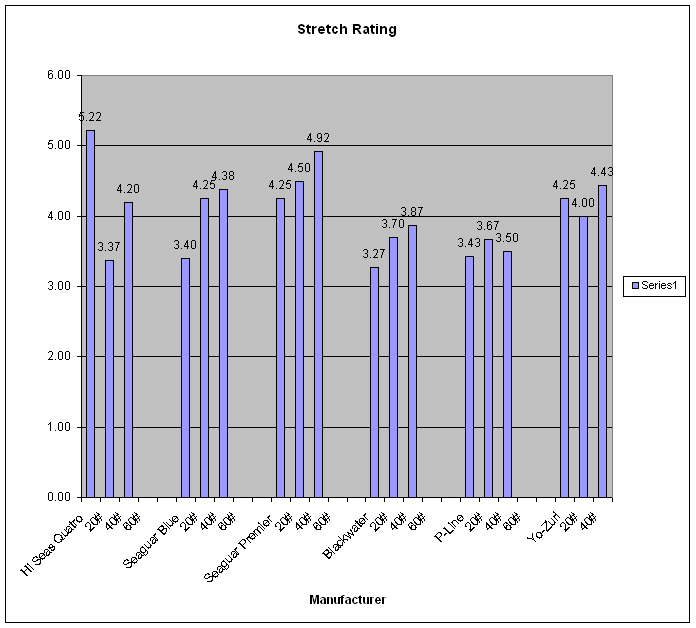
|
Stretch measurements were made in inches, the
higher the number the better for most applications. Seaguar
Premier's line scored the best in this regard in all tests, with one
exception. However, that one exception also had much higher standard
deviation scores which indicate the amount of variance or
inconsistency of performance.
|
|
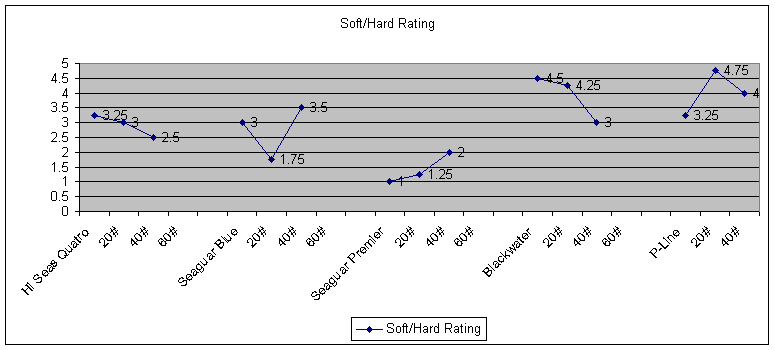
|
The Soft/Hard rating was made using a Leiter
scale, a subjective measure by more than 10 respondents at our shop.
The lower the number the softer the line. People rated the feel of
the line from 1 to 5, with 1 limpest, 5 the hardest or stiffest. Seaguar's Premier scored the best in this category for all line
tests. Line diameter can play a part in this evaluation, thicker
lines are stiffer. So, the diameter measures provide some backing
for the evaluation made by shop patrons and staff in this measure.
In that regard, the results were pretty consistent in terms of
diameter and subjective stiffness ratings. We did not rank the
Yo-Zuri product since it's testing was done later than the rest
of the lines. By feel...not sure. Feels pretty consistent with
Blackwater and Hi Seas...at least to me. Not as limp as Premier,
a little less stiff than Seaguar Blue Label. Subjective, and I
wouldn't want to be held to those comments.
|
| |
| |
The purpose of this study was not to promote or denigrate any
manufacturer's product. We carry all the products listed, and consider
them all good products from reputable firms - otherwise I wouldn't stock
them. But, I personally like to fish, and since I've got the stuff here to
compare, and have the equipment to evaluate the goods, I figured it was
worth an evening's time to check out the products. What I found confirmed
some personal opinions and also resulted in a re-evaluation of some
thoughts about lines we carried and which lines I'll be spending my own
money fishing. You can go over the information, and make your own more
informed opinion based upon what we learned, and what you experience
yourself. Without doubt, I'd suggest that some of the hype I've seen and
heard over the past couple years time is pure bunk, and some of the "new
and improved, third generation Fluorocarbon" claims made by one of the
lines tested was in fact very, very true. Not to name names, but
Blackwater's claim "shock-leader with stretch" is a bit of bolderdash
coupled with poppycock and marketing hype. Seaguar's Premier is the best
fluorocarbon line on the market, based upon our evaluation. And, the
Quatro colored fluorocarbon leader is a real up and comer in the field. This is no definitive study or
comparison, just a fairly quick evaluation of some basic properties.
There's room for more study, wet strength testing being of prime
importance in my estimation. There's also room for confirmation of what I
found, more depth to the evaluation, as well. But, this is a good
beginning, and hopefully cuts through a bit of the smoke and mirrors, hot
air and fog of sales hype.
|



















































